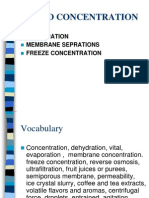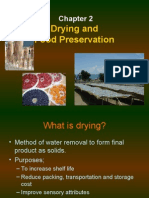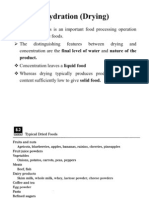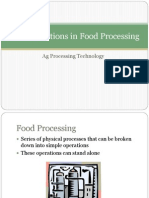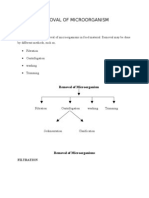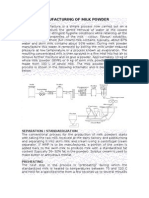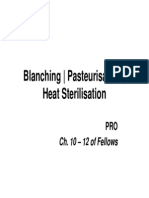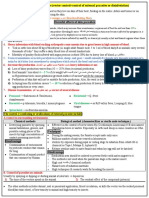Concentration and Evaporation
Concentration and Evaporation
Uploaded by
Nadeesha PereraCopyright:
Available Formats
Concentration and Evaporation
Concentration and Evaporation
Uploaded by
Nadeesha PereraCopyright
Available Formats
Share this document
Did you find this document useful?
Is this content inappropriate?
Copyright:
Available Formats
Concentration and Evaporation
Concentration and Evaporation
Uploaded by
Nadeesha PereraCopyright:
Available Formats
Concentration and Evaporation
What is meant by term Concentration?
Removal of water by means of evaporation or membrane filtration in liquid or semi solid foods with minimal alterations to gain higher solid content.
Examples:
Sweetened condensed milk Fruit and vegetable juices and nectars Sugar syrups Flavored syrups Jams, Jelly, Source Pastes (Tomato)
Relationship between Concentration and Evaporation
The activity what we do is evaporation(or membrane filtration) and then the result is concentration of the food/liquid. (The effect of the evaporation is concentration of the food/liquid.) Evaporation is removal of water from a liquid using heat to get concentrated
Evaporation M. Filtration Concentration
A definition for the Evaporation
Removal of water by vaporizing water in liquid or semi solid foods to gain higher solid content.
Purposes:
-Extend the shelf life (Preservation) -Reduce weight and volume (Economical advantages) . Reduce transport cost . Reduce handling cost . Reduce storage cost and space
Microbe cell [solute] [H2O]
[Solute] [H2O]
Movement of matter from high [ ] to low [ ]. So; water comes out from microbe to external while some solute transfer into microbe. This process disturb the microbial metabolic activities and prevent their growth due to dehydration and solute imbalance.
Basic factors that affect to rate of evaporation
-Rate at which heat can be transferred to the liquid -Quantity of heat required to evaporate each kg of water -Maximum allowable T of the liquid -Pressure at which the evaporation takes place -Changes that may occur in foodstuff during evaporation
1.
Solar Concentration
e.g. Salt separation from solar heat. Advantages:
-No power/fuel required -Low pollution
Disadvantages:
-High time required -Not suitable for most food -Cant control
2.
Open Kettle
Use single/double jacketed vat and gas/wood/steam as heating agent. e.g. Jam, Cordial, Nectar
Fruit and vegetable syrups sources and pastes
Advantages:
-Easy to operate/simple technique -Produce colors and flavors desirable to some products
Disadvantages:
-High TO and high time damage the foods nutrition value -Thickening on walls reduces the heat transferring rate
3.
Flash evaporator
Use clean steam superheated to above 150oC for direct contact with subdivided food material. Use for essence recovery equipment on the basis of different boiling point between essence and water to separate volatile flavor constituents.
Flash Evaporator
4.
Thin film evaporator
Food is pumped to a vertical cylinder with rotating element which spread the food as thin layer on the cylinder wall. Cylinder is double jacketed construction heated by steam. Low TO and time within the cylinder reduces the heat losses.(an advantage)
Thin Film Evaporator
Pilot scale thin film evaporator
5.
Vacuum evaporator
Use low TO vacuum evaporator series. Use for heat sensitive foods e.g. Instant coffee Milk powder Advantages:
-Heat sensitive foods can be evaporated. -Can gain high solute concentration. (effective) -High production rate. (efficient)
Disadvantages:
-High capital cost. NB: When concentrating in lower TO with vacuum may not destroy microbes sufficiently. So, use of additional preservation treatment is required.
Vacuum Evaporator
6.
Freeze concentration
The components of the solution is frozen at once. So, the solution is freeze to make tiny crystals of water. Unfrozen concentrated solution portion is separated from the whole. The whole is centrifuged to separate ice crystals and concentrated solution is passed through fine mash while crystals retain on the mash. Repeat this process to get concentrated solution for several times.
7.
Ultra filtration and Reverse osmosis
(here do not use evaporation technique)
Use ultra filtration membrane which is less tighter and a reverse osmosis membrane which is tighter than latter. These are perm selective membranes. The membranes can be synthetic membranes those made of cellulose acetate or polyamide etc.
Use for;- Fruit juices
Coffee Tea Egg white Soy protein Enzymes Whey separation
Advantages: Disadvantages:
-Low nutrition loss -Low pollution of water
-Non valuable constituents also concentrated
Changes during concentration - Change in color and flavor due to carramalization. It is good in caramal production/candy (made of sugar and milk). -Formation of gritty, sugary jelly or jam. This is ocoured in over concentration due to sugar cristerlization. e.g. Sandiness in milk products -Denaturation of protein results gellation during storage. e.g. Condenced milk -Concentration in higher TO may destroy most of nutrients.
You might also like
- IB Questionbank Chemistry 1Document19 pagesIB Questionbank Chemistry 1zarna nirmal rawalNo ratings yet
- Jul 08 Planetary Gear Box.Document10 pagesJul 08 Planetary Gear Box.RKVSK1No ratings yet
- Concentration and EvaporationDocument21 pagesConcentration and EvaporationRaikaNo ratings yet
- Concentration and EvaporationDocument21 pagesConcentration and EvaporationRaikaNo ratings yet
- Drying MethodsDocument7 pagesDrying MethodsMary KarimiNo ratings yet
- Hort PPT 301 - 350Document22 pagesHort PPT 301 - 350Piyush kumarNo ratings yet
- Food ConcentrationDocument87 pagesFood ConcentrationAPLAshok100% (1)
- Drying (Partial), Freeze Drying, Freeze Concentration, and Pasteurisation Class LectureDocument61 pagesDrying (Partial), Freeze Drying, Freeze Concentration, and Pasteurisation Class Lecturenabil100% (1)
- Learning Module: Surigao State College of TechnologyDocument5 pagesLearning Module: Surigao State College of TechnologyRegine YuNo ratings yet
- Chapter 2 - DryingDocument32 pagesChapter 2 - Dryinghanna162No ratings yet
- Concentration and Drying of Fruit JuicesDocument21 pagesConcentration and Drying of Fruit JuicesMD. Humayun KobirNo ratings yet
- Dehydration Class LectureDocument66 pagesDehydration Class Lecturenabil100% (1)
- EvaporationDocument7 pagesEvaporationPoonatiGiriNo ratings yet
- Thickeners ...Document2 pagesThickeners ...h210502vNo ratings yet
- Tomato Processing: Raw Material QualityDocument10 pagesTomato Processing: Raw Material QualityAdrian LemosNo ratings yet
- Unit Operations in Food ProcessingDocument27 pagesUnit Operations in Food ProcessingKyle KramerNo ratings yet
- Unit Operations in Food ProcessingDocument27 pagesUnit Operations in Food ProcessingSyakirah Tsaqif NatsirNo ratings yet
- Membrane Separation ProcessDocument4 pagesMembrane Separation ProcessJanine Rose MendozaNo ratings yet
- Basic Cooking Methods and Food Preparation TechniquesDocument7 pagesBasic Cooking Methods and Food Preparation TechniquesJeyan BoncavilNo ratings yet
- Form 5 Agri Science Term 1 2020-2021 Handout 9 Week 8Document4 pagesForm 5 Agri Science Term 1 2020-2021 Handout 9 Week 8Ishmael Samuel 4Y ABCCNo ratings yet
- Removal of Microorganism.Document10 pagesRemoval of Microorganism.tamilvkt100% (1)
- Conventional and Advanced Food Processing TechnologiesDocument16 pagesConventional and Advanced Food Processing TechnologiesHenriettah NakisoziNo ratings yet
- Freezing TechnologyDocument66 pagesFreezing TechnologyGurpreet KaurNo ratings yet
- Raw Material QualityDocument15 pagesRaw Material QualityIsanka IndrakumaraNo ratings yet
- Module 6 Concetration and Sugar PreservationDocument25 pagesModule 6 Concetration and Sugar Preservationemiones17No ratings yet
- Food ProcessingDocument24 pagesFood ProcessingJuvy Claire DanigosNo ratings yet
- Energy Efficiency in The Food and Beverages IndustryDocument45 pagesEnergy Efficiency in The Food and Beverages Industrychaudhary_waqar8126No ratings yet
- Fruit Waste ManagementDocument15 pagesFruit Waste Managementdaabgchi100% (1)
- Lecture 4 Methods of Food PreservationDocument76 pagesLecture 4 Methods of Food PreservationCarl James Asilo100% (1)
- Final Freeze PDFDocument6 pagesFinal Freeze PDFpruthvi shahNo ratings yet
- Evaporation: Delivered By: Hafiz Miqdad MasoodDocument25 pagesEvaporation: Delivered By: Hafiz Miqdad MasoodNighat ImranNo ratings yet
- Assignment: TopicDocument9 pagesAssignment: TopicFoodPackaging DPNo ratings yet
- Evaporation Technology Juice Industry GEA Wiegand enDocument12 pagesEvaporation Technology Juice Industry GEA Wiegand enSilvino CruzNo ratings yet
- Dried Fruit: Food and Agriculture Organization of The United NationsDocument13 pagesDried Fruit: Food and Agriculture Organization of The United NationsdoniaNo ratings yet
- Principles of PreservationDocument6 pagesPrinciples of PreservationMary KarimiNo ratings yet
- Food PreservationDocument18 pagesFood PreservationNeca Borromeo100% (1)
- Manufacturing of Milk PowderDocument4 pagesManufacturing of Milk PowderShikha SinghNo ratings yet
- Energy Efficiency in The Food and Beverages IndustryDocument44 pagesEnergy Efficiency in The Food and Beverages IndustryHans De Keulenaer100% (1)
- Assessment 2Document2 pagesAssessment 2Jasmine DelgadoNo ratings yet
- 2 Mark Qus SnackDocument14 pages2 Mark Qus Snackmonicaad shankarNo ratings yet
- Drying and Dehydration of FoodsDocument29 pagesDrying and Dehydration of FoodsKarl Marlou Bantaculo100% (1)
- BrineDocument15 pagesBrinekasun12374590% (1)
- Food PackagingDocument10 pagesFood PackagingAnkNo ratings yet
- By Your Best UnderstandingDocument12 pagesBy Your Best Understandingthanh3445thanhNo ratings yet
- 277 Handling and Storing Fruits and Vegetables: Emperature Ontrol ReezingDocument9 pages277 Handling and Storing Fruits and Vegetables: Emperature Ontrol ReezingGabriela RojasNo ratings yet
- Worldwide Cuisine - Fermentation BasicsDocument25 pagesWorldwide Cuisine - Fermentation BasicsipekkeuNo ratings yet
- JuiceDocument9 pagesJuiceAlfonso Carlos Gutierrez MartinezNo ratings yet
- Tomato ProcessingDocument10 pagesTomato Processingbhabani348100% (1)
- General Principles of Canning and Bottling of FoodsDocument8 pagesGeneral Principles of Canning and Bottling of FoodsDavid Uribe100% (3)
- Removal of Heat Energy: 1. Freeze Drying 2. Freeze ConcentrationDocument19 pagesRemoval of Heat Energy: 1. Freeze Drying 2. Freeze ConcentrationTasmia TasnimNo ratings yet
- Viona Syifa - 40040120650074 - Emulsi EnkapsulasiDocument3 pagesViona Syifa - 40040120650074 - Emulsi EnkapsulasiViona SyifaNo ratings yet
- Blanching, Pasteurisation, SterilisationDocument143 pagesBlanching, Pasteurisation, SterilisationniztgirlNo ratings yet
- FPE20306-2019 - Chapter 3 - Evaporation - TheoryDocument18 pagesFPE20306-2019 - Chapter 3 - Evaporation - TheoryAntonio MoncayoNo ratings yet
- Pepsi Cola Products Philippines Inc1Document13 pagesPepsi Cola Products Philippines Inc1missy forlajeNo ratings yet
- Functions of BlanchingDocument9 pagesFunctions of BlanchingrupaliNo ratings yet
- Dehydration ProcessDocument7 pagesDehydration ProcessSunil BarnwalNo ratings yet
- Fruit Juice ConcentratesDocument26 pagesFruit Juice ConcentratesAakash GillNo ratings yet
- Suppositories & PessariesDocument26 pagesSuppositories & PessariesHamdiNo ratings yet
- Food Processing and Preservation 2Document39 pagesFood Processing and Preservation 2Peter JofilisiNo ratings yet
- Preservation Jam Making, Jelly Making, Marmalade Making, Pickles, Chutneys & Sauces, Bottling Fruit, Finishing Preservation Work for ShowFrom EverandPreservation Jam Making, Jelly Making, Marmalade Making, Pickles, Chutneys & Sauces, Bottling Fruit, Finishing Preservation Work for ShowNo ratings yet
- Brimbal Ave. - Environmental Notification Form - 9.2.14 - Volume 2 of 2Document800 pagesBrimbal Ave. - Environmental Notification Form - 9.2.14 - Volume 2 of 2Matt St HilaireNo ratings yet
- Defects in Rolled Plates & Sheets: Prepared byDocument14 pagesDefects in Rolled Plates & Sheets: Prepared byMahmoudNo ratings yet
- Formulas and Naming Molecular CompoundsDocument10 pagesFormulas and Naming Molecular CompoundsNicolás SerranoNo ratings yet
- Coordination CompoundsDocument60 pagesCoordination CompoundsKassandraNo ratings yet
- Glass-Ceramics Their ProductionDocument69 pagesGlass-Ceramics Their ProductionTomas Jefferson100% (1)
- PCB1EAARA3011Document1 pagePCB1EAARA3011dgii.oftec.car2No ratings yet
- List of Is CodesDocument12 pagesList of Is CodesSanjeev DhariwalNo ratings yet
- Doc-20221013-Wa0 221029 181955Document14 pagesDoc-20221013-Wa0 221029 181955Harman SinghNo ratings yet
- Assay of Benzalkonium ChlorideDocument5 pagesAssay of Benzalkonium ChlorideTantri ayu lestari100% (2)
- Valvoline HD Synthetic Transmission Fluid 50 DR 74130706019Document1 pageValvoline HD Synthetic Transmission Fluid 50 DR 74130706019JUAN BAUTISTANo ratings yet
- Environmental IssuesDocument14 pagesEnvironmental IssuesJhonalden Gocotano Tañares100% (1)
- Physical Science Q1 Module 6Document29 pagesPhysical Science Q1 Module 6Richard MerkNo ratings yet
- Chemical EquilibriumDocument1 pageChemical EquilibriumMibvase IkhuruvoseNo ratings yet
- Cha 4 Standpipe and Hose SystemsDocument48 pagesCha 4 Standpipe and Hose SystemsYoesof HilabyNo ratings yet
- TDS DMN-400-1Document3 pagesTDS DMN-400-1A MahmoodNo ratings yet
- Scientific Program TableDocument10 pagesScientific Program TableMd Iftekhar AhmadNo ratings yet
- Liquid Scintillation Counting For Determination of Radionuclides in Environmental and Nuclear ApplicationDocument35 pagesLiquid Scintillation Counting For Determination of Radionuclides in Environmental and Nuclear ApplicationMelisa IVNo ratings yet
- Stocks FundamentalsDocument616 pagesStocks FundamentalsrajajanarthananNo ratings yet
- CHEM 1071 Course Outline Fall 2022 Updated Sep 08Document8 pagesCHEM 1071 Course Outline Fall 2022 Updated Sep 08ghshshsNo ratings yet
- ControlDocument10 pagesControlAhmed FathiNo ratings yet
- Industrial Pharmacy 1Document9 pagesIndustrial Pharmacy 1Rafal A MkNo ratings yet
- Health Surveillance ResponsibilitiesDocument13 pagesHealth Surveillance ResponsibilitiesFidelis OnenojieideNo ratings yet
- Pharmacognosy: Short Questions Carrying 4 MarksDocument21 pagesPharmacognosy: Short Questions Carrying 4 MarksRajiv DarogaNo ratings yet
- 200/300 BAR INERT GAS Fire Suppression SystemsDocument30 pages200/300 BAR INERT GAS Fire Suppression SystemsKamen GrozdanovNo ratings yet
- Bhopal Gas TragedyDocument1 pageBhopal Gas TragedyaNo ratings yet
- Physical Chemistry 55par Per AnnumDocument3 pagesPhysical Chemistry 55par Per AnnumfredNo ratings yet
- Chemical 8 JuliDocument1 pageChemical 8 JuliAndhy AlfharoNo ratings yet






